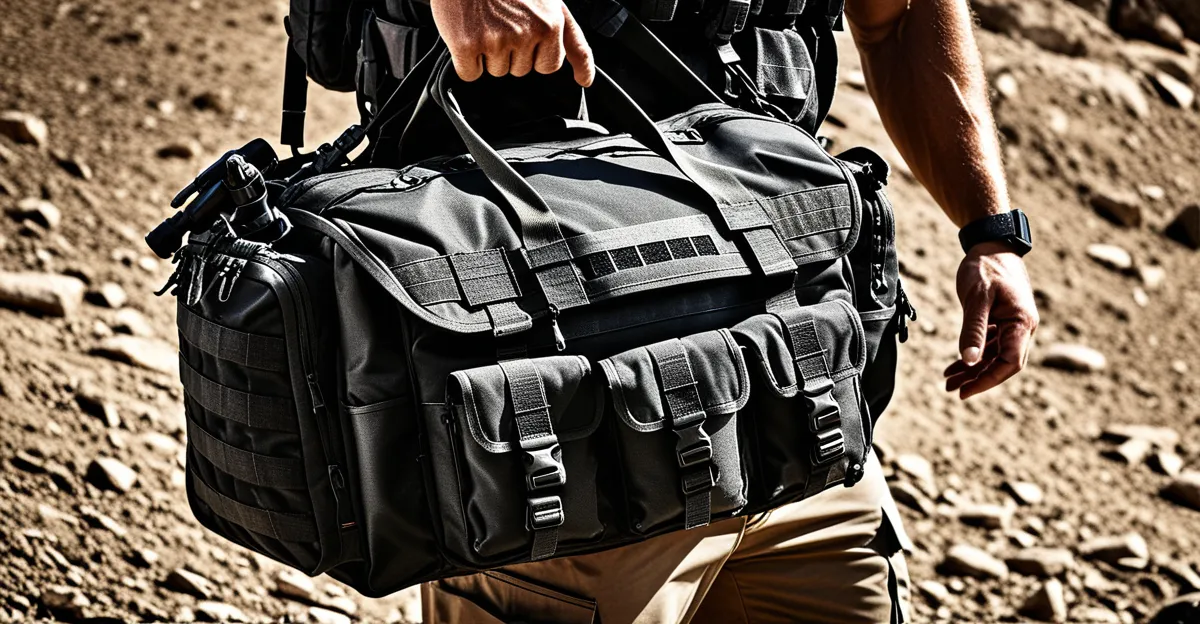Choosing the right tactical bag means balancing toughness, practical design, and personal style. Whether for daily carry, outdoor adventures, or professional use, the best options combine durable materials with smart organisation features. Exploring top brands and models helps you find gear that stands up to demanding conditions while fitting your specific needs and preferences.
Essential Guide to Tactical Bags: Definitions, Features, and Search Intent
The demand for rugged gear is clear: tactical bags are engineered for users who rely on dependability, robust materials, and smart organization. To address these priorities, select the perfect tactical bags for your equipment when outfitting for law enforcement, firefighting, military, or outdoor adventures. This page explains it in detail: select the perfect tactical bags for your equipment.
Also to discover : Essential Tips to Prevent Ankle Injuries While Playing Badminton: Your Ultimate Guide
Built from weather-resistant fabrics with reinforced stitching, modern tactical backpacks feature multiple compartments, ensuring essential items are always accessible and well-protected. Many designs are modular, adopting systems like MOLLE or Lynx™ Laser Cut Platforms, so users can fully customize layouts, adding pouches or accessories as needed.
Organization is at the heart of these packs. Options range from compact 8L satchels to large 62L 3-day backpacks, accommodating everything from hydration systems and first aid kits to firearms or specialist tools. Adjustable ergonomic straps and innovative features—such as concealed carry compartments and quick-access zippers—address both comfort and efficiency under stress.
Topic to read : Revolutionize Synchronized Swimming: Boost Team Unity with Cutting-Edge Underwater Techniques
For buyers, search intent is focused on durability, adaptability, and role-specific features: comparing sizes, compartmentalization, and specialist adaptations such as first responder options or rugged duffel bags for travel. This ensures the chosen gear matches operational demands seamlessly.
Exploring Types of Tactical Bags and Their Main Applications
Backpacks: Modular and Multi-Day Options
Precision: Tactical backpacks are designed for modularity and endurance, allowing efficient load distribution and adaptability for longer missions or strenuous outdoor activities. Main features include weather-resistant materials, MOLLE compatibility for gear attachment, multiple compartments for organization, and reinforced stitching for heavy loads. High-capacity variants like 3-day or expedition backpacks are favored by military, police, and outdoor professionals who require extensive storage, hydration systems, and ergonomic support for prolonged use.
Sling Packs, Waist Pouches, and Satchels for Everyday Carry
Recall: Compact tactical packs, sling packs, and waist pouches cater to everyday portability. These lightweight options offer quick access compartments, secure zippers, and concealed pockets ideal for essentials such as smartphones, wallets, or medical kits. Their streamlined design meets the needs of covert operations, active travel, or daily commuting, while padded straps ensure comfort for extended carry.
Duffels, Gun Cases, and Specialized Carriers for Equipment and Travel
Tactical duffel bags deliver large-capacity solutions for transporting bulky gear or apparel. Specialized gun cases and rifle sleeves provide secure firearm transport, often including reinforced foam and barrel mounts for protection. Utility pouches and organizational carriers accompany these bags, supporting mission-critical tools, first aid supplies, or tech devices, all tailored for field readiness and robust travel.
Materials, Build Quality, and Durability: What Sets Tactical Bags Apart
Common Materials: Nylon, Weather-Resistant Coatings, and Reinforced Stitching
Tactical bags achieve superior durability by using military-grade materials. Most rely on heavy-duty nylon in 500D or 1000D, which combines lightweight properties with exceptional toughness. Add to that, bags feature weather-resistant coatings—typically polyurethane or DWR (Durable Water Repellent)—which effectively repel water and dirt. Reinforced double or triple stitching is standard at stress points, supporting heavy loads without seams or panels failing. These choices make them popular for both military applications and demanding outdoor environments.
Durability Testing, Waterproof Features, and Hardware Strength
Manufacturers test tactical backpacks by subjecting them to weight, abrasion, and impact assessments. Bags designed for waterproof tactical use integrate sealed seams and robust zippers with covered flaps. Quality brands use high-tensile zippers, often YKK, to withstand frequent access and rough handling. Rugged buckles and hardware resist impact and extreme temperatures, ensuring gear remains protected no matter the situation.
Longevity and Maintenance Best Practices
Extending a tactical bag’s life starts with regular cleaning using mild soap and water. Allow bags to dry fully before storage to maintain waterproof coatings. Occasionally check for loose threads or worn areas, and repair any damage promptly. For bags with modular features or detachable components, inspect attachment systems to confirm stability. Adhering to these maintenance practices ensures reliable performance over years of repeated use.
Key Organizational Features: Compartments, Modularity, and Access
Precision: The ideal tactical bag uses multiple compartments to separate gear, while MOLLE or laser-cut systems support modular attachments. Quick-access pockets facilitate fast retrieval, and dedicated sleeves or admin panels keep items organized.
MOLLE and Laser-Cut Systems for Customization
- MOLLE-compatible packs and laser-cut webbing drastically boost customization. Bags like the Tactix series use the Lynx™ Laser Cut Platform, delivering double the mounting points and a 25% strength increase over classic systems.
- This system allows users to attach pouches, tool holsters, and first aid kits, adjusting setups for specialized roles, from medical to firearms or tech.
Internal Compartments, Hydration Sleeves, and Admin Panels
- Multi-compartment tactical packs prevent gear shifting, a key for efficiency in emergencies or outdoor use.
- Common features include hydration sleeves for water bladders, mesh drop pockets, padded sections for electronics, and admin panels for pens, notepads, or ID.
- All compartments often use high-durability zippers and reinforced seams for reliability.
Quick Access Features, Compression Straps, and Expandability
- Tactical bags with quick-access pockets speed up extraction of critical tools or documents.
- Compression straps manage loads and maintain the bag’s profile, while expandable compartments accommodate sudden increases in carry requirements.
- Designs focus on user comfort with ergonomic, adjustable harnesses to reduce fatigue during extended missions.
Comfort, Ergonomics, and User Experience in Tactical Bags
Harness Systems, Load Distribution, and Padding
Optimal comfort is achieved through advanced harness systems and strategic padding. Well-designed tactical backpacks use padded shoulder straps, contoured back panels, and breathable mesh linings to spread weight evenly. This reduces hotspot fatigue and supports longer wear, whether on patrol or during an outdoor trek. Many heavy-duty messenger packs and tactical duffel bags integrate reinforced lumbar support and load-lifter straps, further aiding ergonomic balance. The use of high-density foam in both shoulder and waist belts can notably cushion the load, particularly with models like specialist 1-day or 3-day packs and field-optimized modular tactical backpacks.
Adjustability for Different Body Types and Carrying Needs
Adjustable tactical bag straps allow for quick customisation. Whether you select a compact sling pack, a women’s tactical backpack, or a large model for men, fit remains paramount. Tactical backpacks for women and men now commonly feature extendable chest and waist straps, tailored harness heights, and modular attachment points so the bag adapts to all shapes and activities. These enhancements help distribute weight and keep gear secure—crucial during strenuous missions.
Real-World Feedback from Field Users
Field evaluations underline the value of ergonomic tactical bags, praising their comfort during extended wear in diverse environments. Users highlight how padded shoulder straps and adaptable fit prevent discomfort or injury, especially under the demands of law enforcement or emergency services. Such direct input guides ongoing design advances, ensuring that each tactical bag excels in both function and everyday comfort.
Top Brands, Models, and Buying Considerations
Review of Top-Rated Brands and Notable Models
The leading tactical bag brands deliver strength, adaptability, and reliable organization. Recognized names such as 5.11 Tactical, Warrior Assault Systems, Helikon, and Briliantz consistently appear in lists of best tactical bags for law enforcement and outdoor activities. Product highlights include the robust Warrior Predator and X3 Packs, Tactix series multi-day backpacks, and specialist EMS jump bags for first responders. These bags offer modular storage, reinforced construction, and comfortable ergonomics, supporting professionals facing intense or unpredictable conditions.
Feature Comparisons: Hydration, Security, and Specialty Use
Key comparisons between tactical bags include hydration pack compatibility, security enhancements, and use-case suitability. Many top-rated tactical backpacks feature MOLLE webbing, interior hydration sleeves, and adjustable straps for personalized fit. Models like the Tactix Half-Day and Crosshatch Sling Pack integrate concealed carry options and weather-resistant materials. EMS and medic-specific bags—like First Tactical Jump Bags—feature color-coded compartments and easy-access pockets for critical supplies, excelling where medical response is priority.
Pricing Overview and Value Assessment
Options suit a range of budgets. Affordable tactical backpacks like the Briliantz Tactical Backpack offer solid construction under £70, while specialized rifle cases and large rolling duffel bags climb above £100-£200. Consider durability, organization, and mission adaptability as key value factors when selecting best tactical bag models.
Specialized and Innovative Tactical Bag Solutions
Medical, Rescue, and Professional Use Bags
Precision: Tactical medic packs and first aid tactical bags are engineered to optimize access, organization, and protection for vital supplies during emergencies. Essential features include waterproof or abrasion-resistant bases, segmented pouches for airway, trauma, I.V., and medication kits—each color-coded for rapid identification. Bags such as EMS jump bags use injection-moulded rubber bottoms to resist damage and facilitate easy cleaning. Wide zippered openings and modular internal dividers allow users to adapt layouts to specific scenarios, ensuring readiness for paramedics, field medics, or rapid response teams.
Security Features: RFID Protection, Anti-Theft, Concealed Carry
Precision: Tactical bags with built-in RFID protection shield personal data from digital theft, a growing concern in both urban and field contexts. Anti-theft elements include hidden zippers, lockable compartments, and reinforced exteriors. Concealed carry solutions integrate padded, discrete compartments accessible via quick-twist actions or dedicated Velcro panels. Manufacturers deploy water-resistant nylon, high-density foam, and robust hardware, merging safety with comfort and durability.
Emerging Trends and Niche Applications
Precision: Innovations target expanding professional and recreational needs—tactical bags for photographers now offer customizable foam inserts and rapid gear access panels. Disaster preparedness models include hydration systems, multi-day capacity, and modular attachments. Other specialties, such as RFID-blocking tactical laptop carriers, fuse technology with rugged construction. These solutions continually evolve, meeting demands for adaptability and specialized functionality across fields.



